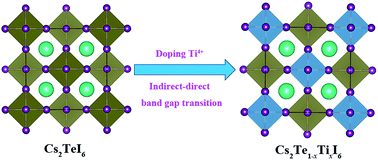Indirect-to-direct band gap transition and optical properties of metal alloys of Cs2Te1−xTixI6: a theoretical study
Abstract
In recent years, double perovskites have attracted considerable attention as potential candidates for photovoltaic applications. However, most double perovskites are not suitable for single-junction solar cells due to their large band gaps (over 2.0 eV). In the present study, we have investigated the structural, mechanical, electronic and optical properties of the Cs2Te1−xTixI6 solid solutions using first-principles calculations based on density functional theory. These compounds exhibit good structural stability compared to CH3NH3PbI3. The results suggest that Cs2TeI6 is an indirect band gap semiconductor, and it can become a direct band gap semiconductor with the value of 1.09 eV when the doping concentration of Ti4+ is 0.50. Moreover, an ideal direct band gap of 1.31 eV is obtained for Cs2Te0.75Ti0.25I6. The calculated results indicate that all the structures are ductile materials except for Cs2Te0.50Ti0.50I6. Our results also show that these materials possess large absorption coefficients in the visible light region. Our work can provide a route to explore stable, environmentally friendly and high-efficiency light absorbers for use in optoelectronic applications.

- This article is part of the themed collection: Celebrating 60 years of the Fujian Institute of Research on the Structure of Matter


 Please wait while we load your content...
Please wait while we load your content...